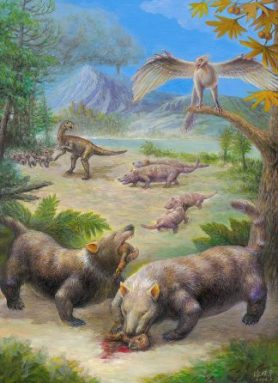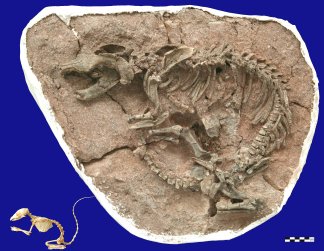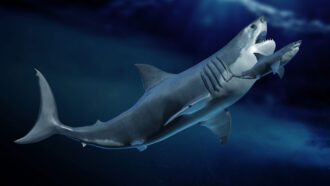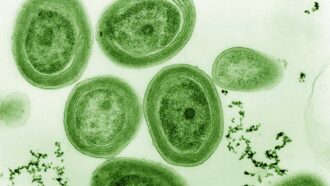Dino takeout for mammals
Ancient mammals dined on young dinosaurs
By Emily Sohn
Dinosaurs were big. Mammals, on the other hand, were puny when the dinosaurs were around. Right?
New discoveries in China are challenging the idea that dinos ruled the land before they became extinct 65 million years ago. Some mammals, it turns out, were much bigger and stronger than previously thought. Some even ate baby dinosaurs!
 |
|
Two mammals, which lived in Asia about 130 million years ago, dine on a dinosaur hatchling. These ancient mammals were about the size of a badger.
|
| © Institute of Vertebrate Paleontology and Paleoanthropology, Chinese Academy of Sciences/Artist: Xiaoping Xu |
The evidence is remarkable. Paleontologists from the American Museum of Natural History in New York dug up fossils that were more than just piles of bones. The researchers found mammals that had been frozen in time by ash from an ancient volcanic eruption. Their bodies were still largely intact.
One of the creatures was 1 meter (about 3 feet) long. Named Repenomamus giganticus, the mammal was sturdy and low to the ground— like a modern badger. R. giganticus probably weighed between 12 and 14 kilograms (26–31 pounds). That makes it the biggest mammal known to have lived during the dinosaurs’ 170-million-year reign on the planet.
The other creature is called Repenomamus robustus. It was smaller than its R. giganticus relative—about the size of an opossum. Even more interesting was what it had inside its rib cage. There, the scientists found a wad of broken bones and teeth. These remains also included a skull and other pieces, just as if an animal had been eaten in chunks.
 |
|
The skeleton of Repenomamus giganticus was much larger than the skeleton of a tree shrew, another mammal that also lived at the same time.
|
| © Institute of Vertebrate Paleontology and Paleoanthropology, Chinese Academy of Sciences/Photographer: Wei Gao |
Analyses of the meal suggest that Repenomamus had eaten a young Psittacosaurus, a common type of plant-eating dinosaur. When it was eaten, this dinosaur was roughly the length of a human hand. Fully grown, it would have been about 2 meters (6 feet) long.
The discoveries are really shaking up the way paleontologists picture the age of dinosaurs. Mammals at that time may not have been so wimpy after all. Some of them might even have been a force to be reckoned with.







